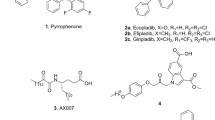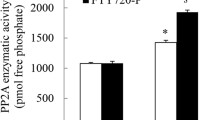Abstract
Three recently developed selective phospholipase D (PLD) inhibitors N-(2-(4-(2-oxo-2,3-dihydro-1H-benzo[d]imidazol-1-yl)piperidin-1-yl)ethyl)-2-naphthamide (VU0155056), (S)-N-(1-(4-(5-chloro-2-oxo-2,3-dihydro-1H-benzo[d]imidazol-1-yl)piperidin-1-yl)propan-2-yl)-2-naphthamide (VU0155069), and N-(2-(4-oxo-1-phenyl-1,3,8-triazaspiro[4,5]decan-8-yl)ethyl)quinoline-3-carboxamide (VU0285655-1) inhibited O2 •− generation in formyl-Met-Leu-Phe (fMLP)-stimulated rat neutrophils. A novel 2-phenyl-4-quinolone compound 6-chloro-2-(2-chlorophenyl)-4-oxo-1,4-dihydroquinoline-3-carboxylate (Fal-002-2), which inhibited O2 •− generation, also reduced the fMLP- but not phorbol ester-stimulated PLD activity (IC50 16.0 ± 5.0 μM). Fal-002-2 attenuated the interaction of PLD1 with ADP-ribosylation factor (Arf) 6, Ras homology (Rho) A and protein kinase C (PKC) isoforms (α, βI, and βII), and also inhibited the membrane recruitment of Arf6 and RhoA in fMLP-stimulated neutrophils, but not in GTPγS-stimulated cell-free system. The cellular levels of GTP-bound Arf6 and GTP-bound RhoA were reduced by Fal-002-2. Fal-002-2 also attenuated the membrane recruitment of Rho-associated protein kinase 1, phosphorylation of myosin light chain 2 at Thr18/Ser19 and PLD1 at Thr147, and the interaction of Arf6 with both arfaptin 1 and phosphatidylinositol 4-phosphate 5-kinase 1A. The association between RhoA and Vav, the interaction of Vav with both Lyn and Lck, the membrane recruitment of Vav, and the phosphorylation of Vav at Tyr174, but not Src family at Tyr416, were all attenuated by Fal-002-2 in fMLP-stimulated neutrophils. These results indicate that Fal-002-2 is not a direct PLD inhibitor, but the inhibition of fMLP-stimulated PLD activity by Fal-002-2, which partly accounts for its suppression of O2 •− generation, is attributable to the blockade of both Arf6 and RhoA activation and attenuation of the interaction of Arf6, RhoA and PKC isoforms with PLD1 in rat neutrophils.








Similar content being viewed by others
References
Aghazadeh B, Lowry WE, Huang XY, Rosen MK (2000) Structural basis for relief of autoinhibition of the Dbl homology domain of proto-oncogene Vav by tyrosine phosphorylation. Cell 102:625–633
Brown FD, Rozelle AL, Yin HL, Balla T, Donaldson JG (2001) Phosphatidylinositol 4,5-bisphosphate and Arf6-regulated membrane traffic. J Cell Biol 154:1007–1017
Chang LC, Chen CM, Wang JP (2003) Inhibition of formyl-methionyl-leucyl-phenylalanine-stimulated of phospholipase D activation in rat neutrophils by the synthetic isoquinoline DMDI. Biochim Biophys Acta 1620:191–198
Chang LC, Huang TH, Chang CS, Tsai YR, Lin RH, Lee PW, Hsu MF, Huang LJ, Wang JP (2011) Signaling mechanisms of inhibition of phospholipase D activation by CHS-111 in formyl peptide-stimulated neutrophils. Biochem Pharmacol 81:269–278
Chardin P, Paris S, Antonny B, Robineau S, Béraud-Dufour S, Jackson CL, Chabre M (1996) A human exchange factor for ARF contains Sec7- and pleckstrin-homology domains. Nature 384:481–484
Cross AR, Segal AW (2004) The NADPH oxidase of professional phagocytes—prototype of the NOX electron transport chain systems. Biochim Biophys Acta 1657:1–22
Donaldson JG (2003) Multiple roles for Arf6: sorting, structuring, and signaling at the plasma membrane. J Biol Chem 278:41573–41576
Donaldson JG, Jackson CL (2011) ARF family G proteins and their regulators: roles in membrane transport, development and disease. Nat Rev Mol Cell Biol 12:362–375
D’Souza-Schorey C, Chavrier P (2006) ARF proteins: roles in membrane traffic and beyond. Nat Rev Mol Cell Biol 7:347–358
Franco M, Peters PJ, Boretto J, van Donselaar E, Neri A, D’Souza-Schorey C, Chavrier P (1999) EFA6, a sec7 domain-containing exchange factor for ARF6, coordinates membrane recycling and actin cytoskeleton organization. EMBO J 18:1480–1491
Fumagalli L, Zhang H, Baruzzi A, Lowell CA, Berton G (2007) The Src family kinases Hck and Fgr regulate neutrophil responses to N-formyl-methionyl-leucyl-phenylalanine. J Immunol 178:3874–3885
Funakoshi Y, Hasegawa H, Kanaho Y (2010) Activation mechanisms of PIP5K isozymes by the small GTPase ARF6. Adv Enzyme Regul 50:72–80
Gomez-Cambronero J, Di Fulvio M, Knapek K (2007) Understanding phospholipase D (PLD) using leukocytes: PLD involvement in cell adhesion and chemotaxis. J Leukoc Biol 82:272–281
Guillemain I, Exton JH (1997) Effects of brefeldin A on phosphatidylcholine phospholipase D and inositolphospholipid metabolism in HL-60 cells. Eur J Biochem 249:812–819
Halliwell B, Gutteridge JM (1990) Role of free radicals and catalytic metal ions in human disease: an overview. Methods Enzymol 186:1–85
Han J, Das B, Wei W, Van Aelst L, Mosteller RD, Khosravi-Far R, Westwick JK, Der CJ, Broek D (1997) Lck regulates Vav activation of members of the Rho family of GTPases. Mol Cell Biol 17:1346–1353
Houle MG, Naccache PH, Bourgoin S (1999) Tyrosine kinase-regulated small GTPase translocation and the activation of phospholipase D in HL60 granulocytes. J Leukoc Biol 66:1021–1030
Jiang H, Luo JQ, Urano T, Frankel P, Lu Z, Foster DA, Feig LA (1995) Involvement of Ral GTPase in v-Src-induced phospholipase D activation. Nature 378:409–412
Kanaho Y, Kobayashi-Nakano A, Yokozeki T (2007) The phosphoinositide kinase PIP5K that produces the versatile signaling phospholipid PI4,5P2. Biol Pharm Bull 30:1605–1609
Kanoh H, Williger BT, Exton JH (1997) Arfaptin 1, a putative cytosolic target protein of ADP-ribosylation factor, is recruited to Golgi membranes. J Biol Chem 272:5421–5429
Klarlund JK, Tsiaras W, Holik JJ, Chawla A, Czech MP (2000) Distinct polyphosphoinositide binding selectivities for pleckstrin homology domains of GRP1-like proteins based on diglycine versus triglycine motifs. J Biol Chem 275:32816–32821
Kureishi Y, Kobayashi S, Amano M, Kimura K, Kanaide H, Nakano T, Kaibuchi K, Ito M (1997) Rho-associated kinase directly induces smooth muscle contraction through myosin light chain phosphorylation. J Biol Chem 272:12257–12260
Lai YY, Huang LJ, Lee KH, Xiao Z, Bastow KF, Yamori T, Kuo SC (2005) Synthesis and biological relationships of 3′,6-substituted 2-phenyl-4-quinolone-3-carboxylic acid derivatives as antimitotic agents. Bioorg Med Chem 13:265–275
Lavieri R, Scott SA, Lewis JA, Selvy PE, Armstrong MD, Brown HA, Lindsley CW (2009) Design and synthesis of isoform-selective phospholipase D (PLD) inhibitors: Part II. Identification of the 1,3,8-triazaspiro[4,5]decan-4-one privileged structure that engenders PLD2 selectivity. Bioorg Med Chem Lett 19:2240–2243
Lewis JA, Scott SA, Lavieri R, Buck JR, Selvy PE, Stoops SL, Armstrong MD, Brown HA, Lindsley CW (2009) Design and synthesis of isoform-selective phospholipase D (PLD) inhibitors: Part I. Impact of alternative halogenated privileged structures for PLD1 specificity. Bioorg Med Chem Lett 19:1916–1920
Lopez I, Burns DJ, Lambeth JD (1995) Regulation of phospholipase D by protein kinase C in human neutrophils. Conventional isoforms of protein kinase C phosphorylate a phospholipase D-related component in the plasma membrane. J Biol Chem 270:19465–19472
Marcil J, Harbour D, Houle MG, Naccache PH, Bourgoin S (1999) Monosodium urate crystal-stimulated phospholipase D in human neutrophils. Biochem J 337:185–192
McDermott M, Wakelam MJ, Morris AJ (2004) Phospholipase D. Biochem Cell Biol 82:225–253
Norton LJ, Zhang Q, Saqib KM, Schrewe H, Macura K, Anderson KE, Lindsley CW, Brown HA, Rudge SA, Wakelam MJ (2011) PLD1 rather than PLD2 regulates phorbol-ester-, adhesion-dependent and Fcγ-receptor-stimulated ROS production in neutrophils. J Cell Sci 124:1973–1983
Paruch S, El-Benna J, Djerdjouri B, Marullo S, Perianin A (2006) A role of p44/42 mitogen-activated protein kinases in formyl-peptide receptor-mediated phospholipase D activity and oxidant production. FASEB J 20:142–144
Rais S, Pedruzzi E, Dang MC, Giroud JP, Hakim J, Perianin A (1998) Priming of phosphatidic acid production by staurosporine in f-Met-Leu-Phe-stimulated human neutrophils: correlation with respiratory burst. Cell Signal 10:121–129
Sato T, Hongu T, Sakamoto M, Funakoshi Y, Kanaho Y (2013) Molecular mechanisms of N-formyl-methionyl-leucyl-phenylalanine-induced superoxide generation and degranulation in mouse neutrophils: phospholipase D is dispensable. Mol Cell Biol 33:136–145
Someya A, Sata M, Takeda K, Pacheco-Rodriguez G, Ferrans VJ, Moss J, Vaughan M (2001) ARF-GEP(100), a guanine nucleotide-exchange protein for ADP-ribosylation factor 6. Proc Natl Acad Sci USA 98:2413–2418
Song J, Khachikian Z, Radhakrishna H, Donaldson JG (1998) Localization of endogenous ARF6 to sites of cortical actin rearrangement and involvement of ARF6 in cell spreading. J Cell Sci 111:2257–2267
Su W, Yeku O, Olepu S, Genna A, Park JS, Ren H, Du G, Gelb MH, Morris AJ, Frohman MA (2009) 5-Fluoro-2-indolyl deschlorohalopemide (FIPI), a phospholipase D pharmacological inhibitor that alters cell spreading and inhibits chemotaxis. Mol Pharmacol 75:437–446
Tarricone C, Xiao B, Justin N, Walker PA, Rittinger K, Gamblin SJ, Smerdon SJ (2001) The structural basis of Arfaptin-mediated cross-talk between Rac and Arf signaling pathways. Nature 411:215–219
Tsai YR, Huang LJ, Lin HY, Hung YJ, Lee MR, Kuo SC, Hsu MF, Wang JP (2013) Inhibition of formyl peptide-stimulated superoxide anion generation by Fal-002-2 occurs mainly through the blockade of the p21-activated kinase and protein kinase C signaling pathways in rat neutrophils. Eur J Pharmacol 701:114–123
Tsao LT, Wang JP (1997) Translocation of protein kinase C isoforms in rat neutrophils. Biochem Biophys Res Commun 234:412–418
Walker SJ, Brown HA (2002) Specificity of Rho insert-mediated activation of phospholipase D1. J Biol Chem 277:26260–26267
Wang JP, Chang LC, Raung SL, Hsu MF, Huang LJ, Kuo SC (2002) Inhibition of superoxide anion generation by YC-1 in rat neutrophils through cyclic GMP-dependent and -independent mechanisms. Biochem Pharmacol 63:577–585
Williams JC, Wierenga RK, Saraste M (1998) Insights into Src kinase functions: structural comparisons. Trends Biochem Sci 23:179–184
Zeniou-Meyer M, Begle A, Bader MF, Vitale N (2009) The Coffin–Lowry Syndrome-associated protein RSK2 controls neuroendocrine secretion through the regulation of phospholipase D1 at the exocytotic sites. Ann NY Acad Sci 1152:201–208
Acknowledgments
This work was supported in part by grants from the National Science Council (NSC-94-2320-B-075A-005) and Taichung Veterans General Hospital (TCVGH-1007303C), Taiwan, Republic of China.
Author information
Authors and Affiliations
Corresponding author
Additional information
M.-F. Hsu and J.-P. Wang contributed equally to this study.
Rights and permissions
About this article
Cite this article
Tsai, YR., Huang, LJ., Lin, HY. et al. Inhibition of formyl peptide-stimulated phospholipase D activation by Fal-002-2 via blockade of the Arf6, RhoA and protein kinase C signaling pathways in rat neutrophils. Naunyn-Schmiedeberg's Arch Pharmacol 386, 507–519 (2013). https://doi.org/10.1007/s00210-013-0851-6
Received:
Accepted:
Published:
Issue Date:
DOI: https://doi.org/10.1007/s00210-013-0851-6




